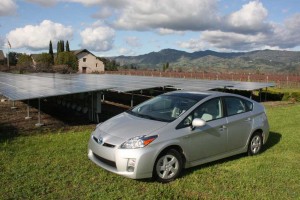Toyota has reversed directions on its plan to produce the popular Prius hybrid here in the United States, and will now delay that move until at least 2016, according to a senior company official.
Despite growing demand for alternative propulsion – and increasing production by its North American-based competitors – Toyota’s production chief, Atsushi Nimmi, told reporters the technology for key hybrid components is “not mature enough” to take out of Japan.
Making the move to an American plant, he suggested, would have to wait until the next-generation Prius is ready, something now scheduled to happen until 2016.
The decision comes in sharp contrast with previous Toyota pronouncements.
During the gasoline price spike of 2008, when fuel costs topped $4 and sales of the Prius and other hybrid-electric vehicles also set new records, Toyota said it would begin building the distinctive, high-mileage sedan at a new plant near Tupelo, Mississippi.
But soon afterwards, as the U.S. auto market began to plunge into a deep recession, Toyota announced it would put that partially-completed plant on indefinite hold, with Prius production plans, in particular, left in the air.
Earlier this month, Toyota took Tupelo out of idle mode, saying it would now complete the assembly plant – but would instead use the facility to produce the compact Corolla model. One of Toyota’s top-sellers, Corolla needed a new U.S. home because the maker decided to shutter a plant in California that had been building the car.
So, for at least another six years, Nimmi suggested, Prius will continue to be sourced from Japan.
“The main components for the Prius such as the motor and battery are not mature enough for local production,” he explained during a conversation with reporters in Tokyo. “We expect that they’ll be ready with the next remodeling,” added Nimmi, who also serves as director of regional operations in both China and North America.
The Toyota Prius has been the world’s most popular hybrid almost since its debut, more than a decade ago. But competition continues to grow, with virtually every automaker planning to add some form of hybrid to its line-up. Hyundai, for example, will launch its first gas-electric model, a version of the Sonata, for 2011.
Meanwhile, more advanced versions of the technology are beginning to appear, notably including the Chevrolet Volt, an extended-range electric vehicle, or E-REV, that will launch in November. Even Porsche now plans a plug-in hybrid. (Click Here for more on Porsche’s plug-in 918.)
Toyota will introduce its own plug-in next year, a version of the Prius with a larger lithium-ion battery pack. But the current Toyota Hybrid Synergy Drive system is being stretched to its limits. Where Volt will be able to get 40 miles per charge, and run on electric power at 90 mph, the Prius plug-in is expected to yield just 17 miles battery range, and operate in electric mode at no more than 62 mph.
The automaker will reportedly seek to address such limitations with the 2016 Prius remake. What’s unclear is whether Toyota will go it alone or will turn to Tesla, the California battery car maker with which it recently announced plans to develop a new battery-electric vehicle.


This is misleading:
“Toyota will introduce its own plug-in next year, a version of the Prius with a larger lithium-ion battery pack. But the current Toyota Hybrid Synergy Drive system is being stretched to its limits. Where Volt will be able to get 40 miles per charge, and run on electric power at 90 mph, the Prius plug-in is expected to yield just 17 miles battery range, and operate in electric mode at no more than 62 mph.”
The Prius is a hybrid. The fact that it requires the ICE for propulsion about 62-mph is moot. Top speeds are still going to be about 110-mph.
One wonders how long the Volt will run at 90-mph before it’s ICE kicks in? Also, how fast does that 40 miles per charge drop when you use the air conditioner or heater?
Regards,
Lew
I understand the prius is being produced in China for local comsumption. So much for maturity vs Chinese mussle.